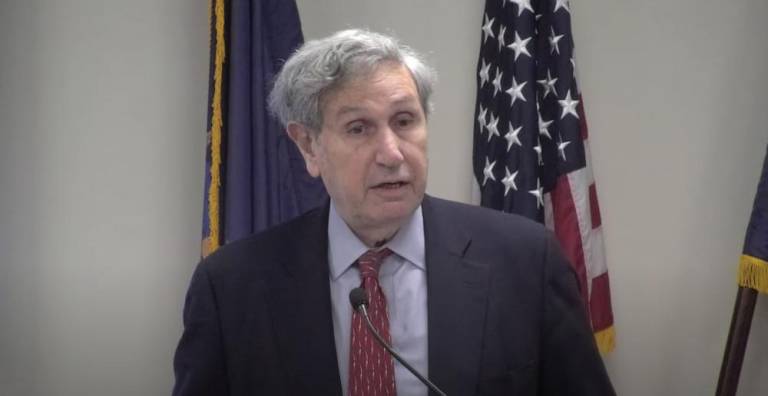Congestion Pricing Board Wants $15 Base Toll, Mayor Adams Wants More Debate
The MTA’s Traffic Mobility Board is recommending a $15 base toll, higher prices for trucks, and discounts for low-income and night drivers. The recommendations now go to the full MTA Board. In a preview of potential political conflict, Mayor Eric Adams has called the recommendations the mere “beginning of the conversation.” Governor Kathy Hochul, meanwhile, is fully supportive.

The MTA’s Traffic Mobility Board is recommending a baseline toll of $15 for drivers entering the congestion pricing zone–or Central Business District–below 60th St. It’ll be sending the suggestions to the full MTA Board on Dec. 6th. If the MTA Board approves them after a series of public hearings that begin in February, the tolls could start to be collected as soon as late April or early May.
Mayor Eric Adams–expressing notable ambiguity on the suggested tolling rollout, which he has supported in the past–told reporters at a press conference that “the $15 proposal is the beginning of the conversation.”
”I think that anyone that’s driving into the city for luxury purposes or convenience, they need to pay whatever the price is. Those who are there for necessities, such as a medical treatment that is mandatory by a certain professional, we need to take that into account,” he elaborated.
Conversely, Governor Kathy Hochul appeared at a December 5 rally held at Union Square to demonstrate support for the suggested base toll. “We are fighting to save our planet, we’re fighting to save our kids, we’re fighting for our riders, and we’re fighting for the greatest city on the planet, the city of New York,” she exclaimed.
According to a report officially released by the Traffic Mobility Board on Nov. 30, “traffic is bad for public health–increasing air and noise pollution and increasing emergency vehicle response times.” The Board adds that congestion “is bad for the economy–costing businesses, commuters, and residents a staggering $20 billion a year.”
The advisory board’s chairperson, Carl Weisbrod, said that imposing a fee on cars entering the CBD will bolster the environment and mass transit; he added that the program specifically maintains the three goals of “reducing congestion in the region, reducing pollution in the region, and generating funds for the MTA’s Capitol Program.”
The pricing plan has faced pushback from a range of other players. Some community boards have demonstrated chunks of opposition, while the state of New Jersey sued, claiming it would send pollution across the Hudson River if drivers avoided the tolls. It would also be layered on top of tolls that some NJ drivers have to pay upon entering the city. The new plan does offer a $5 discount for cars that enter via the Lincoln and Holland Tunnels.
Weisbrod appeared to acknowledge both grassroots and interstate opposition during the briefing, but did so in a way that firmly stood behind the thrust of the program.
“The guiding principle for us was: how do we satisfy the many, not the few? We really recognize that the many are the million plus people that take mass transit into the CBD every day, and the relatively few are the 150,000 or so people who drive,” he said.
He nonetheless noted that “fairness” nonetheless played a heavy role in the Board’s deliberations, clarifying that the need to “satisfy” the “interests” of the smaller number of people who drive was important as well.
This means that some exceptions were taken into account, even though a significant chunk were shot down. For example, tolls for taxis would come in at $1.25 fee paid by passengers. The recommended toll for FHVs (for-hire vehicles such as Uber and Lyft) sits at $2.50 per passenger. Motorcycles would be tolled at half-price, or $7.50.
The tolls would be in effect from 5 a.m. until 9 p.m. on weekdays. Discounts would come into play in the hours after. Overnight discount hours were originally set to begin at midnight.
The expansion of nighttime hours was not random, Weisbord explained. Since trucks and buses are set to pay considerably more than the baseline toll–between $24 and $36–they would be incentivized to drive during discounted overnight hours. In turn, this would ideally reduce truck congestion, providing a dip in the strongest source of pollution for neighborhoods with “environmental justice” concerns.
The Traffic Mobility Board also recommended raising the discount for low-income drivers to 50 percent, instead of an earlier version proposing a 25 percent toll reduction.
MTA Chair and CEO Janno Lieber praised the Traffic Mobility Board’s suggestions and findings, proclaiming that “I am so grateful that this all-star panel has produced an incredibly thoughtful, detailed and balanced report that points the way forward for effective implementation of congestion pricing.”
”Congestion pricing will mean less traffic, cleaner air, safer streets and better transit,” he concluded.
So far, about 60 percent of the tolling infrastructure has been installed on New York City streets.